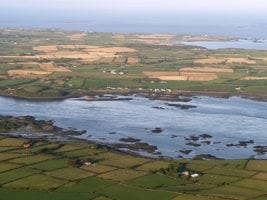- Created: August 28, 2012 10:32 am
- Updated: December 12, 2017 11:02 am
Categories:
Location: Down
- Distance Instructions
Label
- Distance 0 m
- Time 0 s
- Speed 0.0 km/h
- Min altitude 0 m
- Peak 0 m
- Climb 0 m
- Descent 0 m
Powerful tidal currents enhance the richness of marine life around the islands and rocky outcrops of this area. Turbulence created by the action of strong currents on submerged rocks is revealed on the surface to dramatic effect at the Routen Wheels whirlpool.
Excellent examples of marine habitats and a great variety of sea life are protected within the reserve. Edible crabs, squat lobsters and sea urchins are common here, living beside starfish normally found in Arctic waters. Areas of soft mud and gravel are home to countless different worms, shellfish and sea-cucumbers. A red seaweed - carrageen or Irish Moss - grows in the most exposed areas, while blue-rayed limpets burrow into the stems of huge kelp plants in deeper water.
Piles of seaweed, carried up by high tides and left to decompose on the strandline, attract pipits, wagtails and wading birds which feed on the flies and other small animals living amongst the weed.
Teal and other wildfowl often gather here in winter. Both grey and common seals haul out of the sea at low tide, favouring the rocks around the beacon. The haunting howl of the grey seal can often be heard from the shore, distinguishing it from the common seals.
Gallery
Powerful tidal currents enhance the richness of marine life around the islands and rocky outcrops of this area. Turbulence created by the action of strong currents on submerged rocks is revealed on the surface to dramatic effect at the Routen Wheels whirlpool.
Excellent examples of marine habitats and a great variety of sea life are protected within the reserve. Edible crabs, squat lobsters and sea urchins are common here, living beside starfish normally found in Arctic waters. Areas of soft mud and gravel are home to countless different worms, shellfish and sea-cucumbers. A red seaweed – carrageen or Irish Moss – grows in the most exposed areas, while blue-rayed limpets burrow into the stems of huge kelp plants in deeper water.
Piles of seaweed, carried up by high tides and left to decompose on the strandline, attract pipits, wagtails and wading birds which feed on the flies and other small animals living amongst the weed.
Teal and other wildfowl often gather here in winter. Both grey and common seals haul out of the sea at low tide, favouring the rocks around the beacon. The haunting howl of the grey seal can often be heard from the shore, distinguishing it from the common seals.


